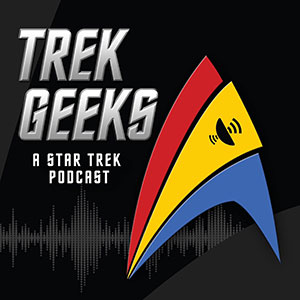The latest episode of the highly-respected fan-series, Star Trek: Phase II, has been released.
“Kitumba”, a two-part story draft for the ill-fated Star Trek: Phase II television series in 1977, was rewritten into a single episode for the fan-made series. Much of the episode takes place on Qo’nos, the Klingon homeworld. The Phase II website notes that members of the International Klingon Federation donated their time for the on-location shoots in Fort Ticonderoga, New York.
The hour-long episode bridges the gap between the Klingons seen in TOS and those seen in the feature films.
Check out the entire episode below.



























![2023: A banner year for Star Trek — here’s why [Op-Ed]](https://treknews.net/wp-content/uploads/2024/01/star-trek-2023-year-in-review-600x337.jpg)












![[REVIEW] STAR TREK: SHORT TREKS "Children of Mars": All Hands... Battlestations](https://treknews.net/wp-content/uploads/2020/01/review-star-trek-short-treks-children-of-mars.jpg)



























Christopher Dalton
November 22, 2015 at 11:32 pm
One of the many things that can be said about the popularity of Star Trek, as well as its longevity, is the series’ ability to address the social and political issues of the times that we live in.
Through the creative tracking of science fiction writing, Star Trek has been able to make various forms of social commentary on controversial situations. Situations ranging from hot-topics about war to overpopulation to environmental problems to other more immediate and domestic problems that continue to affect our planet and human society to this day.
As the late Gene Roddenberry intended, Star Trek is a 23rd Century morality play/social allegory that holds a mirror up to us. One fully dictating what gets reflected back and describing the cultural and political issues of our world.
The latest episode of the award-winning Star Trek-New Voyages/Phase 2 does an excellent job in upholding that tradition that began nearly fifty years past. One that delivers with dazzling results.
Despite the behind-the-scenes production problems that were
instigated illegally by Vic Mignogna, as well as his and Michele Specht’s unprofessional behavior and juvenille antics, ‘Kitumba’ shows brilliantly what Star Trek still does its most best at. If nothing else, this well
written episode by both the late John Meredyth Lucas and Patty Wright depicts the brutal absurdity of war and the mishandling of political power.
Two social and political issues equally handled with excellent, crystal clear as glass, and razor-sharp results.
Like Star Trek VI-The Undiscovered Country, Kitumba gives Star Trek fans another glimpse into the Klingon Empire’s culture and government. One that clearly depicts the inner workings of the latter and what often happens within the corridors of power, itself. The mishandlings, if not misuse, of government power and the consequences(often ill-fated and fatal), there of.
We are also given a brilliant fortaste as to what is yet to come, concerning the formation of the Klingon High Council. The seed of such an idea, for which, is formed in the mind of the Kitumba(a descendent of the great Klingon Warrior Kahless), himself. A character played brilliantly by newcomer Kario Pereira-Bailey.
“Kitumba” depicts the U.S.S. Enterprise on a suicide mission to the heart of the Klingon Empire. Pulled in every direction by warlords and people that have their own agenda, the Kitumba suddenly finds himself confronting his very enemy: Captain James T. Kirk and the crew of the starship Enterprise. The choices he makes will resonate through the galaxy for years to come.
Kirk and the crew of the Enterprise are sent on a secret mission to the Klingon home world Qo’nos, much of which is still very shrouded in mystery to the Federation and Starfleet. With the help of a Klingon that is aiding the Federation, Starfleet Intelligence learns that a strong faction within the Klingon government is planning a war on a massive scale against the United Federation of Planets in strict violation of the Organian Peace Treaty. The leader of this growing faction is bold because it appears
the Organians are no longer monitoring the activity between the Federation and the Empire. It becomes the job of Kirk and crew to thwart this attempt at war which would ultimately mean the destruction of both sides. Kirk finds himself walking on the razor-sharp edge of Klingon tradition, duty, and their perception of honor.
The extended-length episode not only explored Klingon society and showed us the home planet, but it bridged the gap between the TOS Klingon Empire and the Klingon Empire we would later see in the first six feature films.
As with the previous exciting episodes, James Cawley, Brandon Stacy, John Kelley, Charles Root, Jr, Jonathan Zungre, Patrick Cawley, Paul R. Sieber, Bobby Quinn Rice, Wayne W. Johnson, Ron Boyd, and to some degree Kim Stinger, do an excellent job in playing the main characters that many fans of the original series have come to know and admire for almost a half a century.
It is a shame that Stinger has been seduced by the ‘evil side of Star Trek fandom’ by becoming a part of Vic Mignogna’s twisted, spiteful, and petty rip-off known as Star Trek Continues. Her true talents are really put to very productive use in this awesome Phase 2 episode. It is both sad and un-nerving that they will now be wasted in Mignogna’s toxic waste disposal-like, rip-off of a production.
On the subject of Mignogna, both his performance, as well as that of his fiance Michele Specht, clearly indicate that these two mentalities of such extreme toxic dementia, were just playing themselves. Their characters’ personalities are nothing more than just their deceitful, petty, spiteful, vindictive, demented, perverted, unprincipled, poisoned, and toxic natures buried under so much make-up prosthetics. Thankfully, the 23rd Century Klingon ‘Bonnie and Clyde-like’ characters that they so-call ‘play'(which happen to be members of the dishonorable and ill-fated Duras family)are killed off near the end, thus ridding and cleansing the universe of their deceitful presence, forever.
There are definately some wonderful and exciting moments in this latest P2 adventure. Plus a few well-written in-joke references to past and future Star Trek events. Kirk mentioning about how he hijacked a corvette and McCoy claiming that he won’t live to see the Klingon Empire in a century were both very brilliant and delightful.
Especially the unique plot twist involving both the Kitumba and the teacher(played wonderfully by Pony Horton)in the Enterprise briefing room. That scene was a huge surprise and a very brilliantly executed one at that. Such plot twists have been rare in Star Trek. This one particular plot twist clearly depicts the complexities of politics and the Machavellian webs of deceit that often go hand in hand with such power plays. Let alone the power players who impliment and execute such agendas. Kudos and compliments to Patty Wright for adding those extra layers into the original script.
The special cameo appearances by Gil Gerard(of the Seventies version of Buck Rogers), Andrew Probert(who worked on the ST-TMP production), and Kenneth Thomson(Captain Raymond Martin of Starship Saladin)were also well acted and delievered brilliantly. The references to Epsilon 9 and the Organians preminition of the Federation and the Klingons working together added another multi-dimensional layer to the classic script written in the Seventies(i.e. when Star Trek nearly came back as a series, before becoming an epic motion picture).
An extra special kudos should be awarded to Paul R. Sieber for Prescott’s one-liners in certain scenes. The briefing room scene involving Prescott, Peter Kirk, and Pavel Chekov discussing strategic countermeasures was played brilliantly and with some good humor. Even when Prescott is disguised as a Klingon, he delievers some excellent one-liners while searching for Kirk and the landing party.
Even the references to Earth’s world history(feudal Japan and England when it wasa Roman Colony)and its comparisons to the culture and social-political structure of the Klingons was also ingenius.
While it is sad that this will be James Cawley’s final appearance as the heroic Captain James T. Kirk(James will be continuing as P2’s Senior Executive Producer)Star Trek– New Voyages/Phase II delivers another exciting and bold new adventure in ‘Kitumba’.